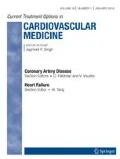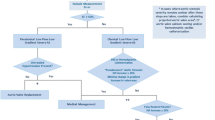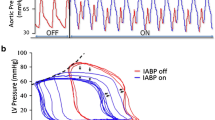Abstract
Purpose of review
The goal of this review is to discuss the effects of Impella (Abiomed, Danvers, MA), to support in the hemodynamics of patients with severe aortic stenosis, and to explore the clinical scenarios in which the use of Impella may be beneficial in this setting.
Recent findings
The management of patients with severe aortic stenosis who go on to develop left ventricular failure and cardiogenic shock remains an important clinical challenge associated with increased morbidity and mortality.
Summary
Once considered a relative contraindication, the use of Impella in severe aortic stenosis has now been proven feasible and demonstrated promising results in selected high-risk patients. The use of Impella to provide hemodynamic support maybe considered in patients with aortic stenosis in cardiogenic shock or those with severe left ventricular dysfunction and CAD who require high-risk PCI and or balloon aortic valvuloplasty. Impella is also an attractive option in selected cases of hemodynamic collapse during TAVR.



Similar content being viewed by others
References and Recommended Reading
Papers of particular interest, published recently, have been highlighted as: • Of importance
Eveborn GW, Schirmer H, Heggelund G, Lunde P, Rasmussen K. The evolving epidemiology of valvular aortic stenosis. the Tromso study. Heart. 2013;99(6):396–400.
• Burzotta F, Trani C, Doshi SN, Townend J, van Geuns RJ, Hunziker P, et al. Impella ventricular support in clinical practice: collaborative viewpoint from a European expert user group. Int J Cardiol. 2015;201:684–91. This paper highlights the grave prognosis of patients with decompensated aortic stenosis. Also discusses the concept of emergency TAVR with the current available devices.
Harjai KJ, O'Neill WW. Hemodynamic support using the Impella 2.5 catheter system during high-risk percutaneous coronary intervention in a patient with severe aortic stenosis. J Interv Cardiol. 2010;23(1):66–9.
Londono JC, Martinez CA, Singh V, O'Neill WW. Hemodynamic support with impella 2.5 during balloon aortic valvuloplasty in a high-risk patient. J Interv Cardiol. 2011;24(2):193–7.
• Martinez CA, Singh V, Londono JC, Cohen MG, Alfonso CE, O'Neill WW, et al. Percutaneous retrograde left ventricular assist support for interventions in patients with aortic stenosis and left ventricular dysfunction. Catheter Cardiovasc Interv. 2012;80(7):1201–9. This is the first single-center feasibility study demonstrating use of Impella in patients with severe aortic stenosis. It reports important hemodynamic findings which operators should be aware of.
• Singh V, Yadav PK, Eng MH, Macedo FY, Silva GV, Mendirichaga R, et al. Outcomes of hemodynamic support with Impella in very high-risk patients undergoing balloon aortic valvuloplasty: results from the Global cVAD Registry. Int J Cardiol. 2017;240:120–5. This is the largest (multicenter, international) and the most contemporary series of the use of Impella device in patients with severe aortic stenosis undergoing high-risk interventions. This also reports long-term outcomes of these patients.
Stouffer GA. Cardiovascular hemodynamics for the clinician. 2nd ed. Chichester: Wiley-Blackwell; 2017. 384 p
• Saikrishnan N, Kumar G, Sawaya FJ, Lerakis S, Yoganathan AP. Accurate assessment of aortic stenosis: a review of diagnostic modalities and hemodynamics. Circulation. 2014;129(2):244–53. State of the art review of accurate assessment of hemodynamics in patients with aortic stenosis.
Singh V, Damluji AA, Mendirichaga R, Alfonso CE, Martinez CA, Williams D, et al. Elective or emergency use of mechanical circulatory support devices during transcatheter aortic valve replacement. J Interv Cardiol. 2016;29(5):513–22.
Arora S, Bahekar AA. Staged high-risk percutaneous coronary intervention with Impella support after on-pump transcatheter aortic valve replacement. Tex Heart Inst J. 2016;43(5):423–7.
Burzotta F, Nerla R, Trani C. Bail-out use of Impella CP as a bridge to TAVI in a cardiogenic shock patient: the “pump-rewiring” technique. J Invasive Cardiol. 2016;28(1):E1–5.
Frisoli TM, Guerrero M, O'Neill WW. Mechanical circulatory support with impella to facilitate percutaneous coronary intervention for post-TAVI bilateral coronary obstruction. Catheter Cardiovasc Interv. 2016;88(1):E34–7.
Megaly M, Jones P. Impella CP-assisted balloon aortic valvuloplasty. J Cardiol Cases. 2016;14:49–51.
Singh V, Yarkoni A, O'Neill WW. Emergent use of Impella CP during transcatheter aortic valve replacement: transaortic access. Catheter Cardiovasc Interv. 2015;86(1):160–3.
Spiro J, Venugopal V, Raja Y, Ludman PF, Townend JN, Doshi SN. Feasibility and efficacy of the 2.5 L and 3.8 L impella percutaneous left ventricular support device during high-risk, percutaneous coronary intervention in patients with severe aortic stenosis. Catheter Cardiovasc Interv. 2015;85(6):981–9.
Thomas MP, Altman A, Magovern GJ Jr, Moraca RJ. Insertion of an Abiomed Impella® left ventricular assist device following bioprosthetic aortic valve placement. J Card Surg. 2013;28(4):469–71.
Ludeman DJ, Schwartz BG, Burstein S. Impella-assisted balloon aortic valvuloplasty. J Invasive Cardiol. 2012;24(1):E19–20.
•Bongiovanni D, Kuhl C, Bleiziffer S, Stecher L, Poch F, Greif M, et al. Emergency treatment of decompensated aortic stenosis. Heart. 2018;104(1):23–29. This paper highlights the grave prognosis of patients with decompensated aortic stenosis. Also discusses the concept of emergency TAVR with the current available devices.
Stewart BF, Siscovick D, Lind BK, Gardin JM, Gottdiener JS, Smith VE, et al. Clinical factors associated with calcific aortic valve disease. Cardiovascular Health Study. J Am Coll Cardiol. 1997;29(3):630–4.
D'Ascenzo F, Conrotto F, Giordana F, Moretti C, D'Amico M, Salizzoni S, et al. Mid-term prognostic value of coronary artery disease in patients undergoing transcatheter aortic valve implantation: a meta-analysis of adjusted observational results. Int J Cardiol. 2013;168(3):2528–32.
Wiegerinck EM, van de Hoef TP, Rolandi MC, Yong Z, van Kesteren F, Koch KT, et al. Impact of aortic valve stenosis on coronary hemodynamics and the instantaneous effect of transcatheter aortic valve implantation. Circ Cardiovasc Interv. 2015;8(8):e002443.
Kodali SK, Williams MR, Smith CR, Svensson LG, Webb JG, Makkar RR, et al. Two-year outcomes after transcatheter or surgical aortic-valve replacement. N Engl J Med. 2012;366(18):1686–95.
Adams DH, Popma JJ, Reardon MJ, Yakubov SJ, Coselli JS, Deeb GM, et al. Transcatheter aortic-valve replacement with a self-expanding prosthesis. N Engl J Med. 2014;370(19):1790–8.
Holmes DR Jr, Mack MJ, Kaul S, Agnihotri A, Alexander KP, Bailey SR, et al. ACCF/AATS/SCAI/STS expert consensus document on transcatheter aortic valve replacement: developed in collaboration with the American Heart Association, American Society of Echocardiography, European Association for Cardio-Thoracic Surgery, Heart Failure Society of America, Mended Hearts, Society of Cardiovascular Anesthesiologists, Society of Cardiovascular Computed Tomography, and Society for Cardiovascular Magnetic Resonance. Catheter Cardiovasc Interv. 2012;79(7):1023–82.
• Ramee S, Anwaruddin S, Kumar G, Piana RN, Babaliaros V, Rab T, et al. The rationale for performance of coronary angiography and stenting before transcatheter aortic valve replacement: from the Interventional Section Leadership Council of the American College of Cardiology. JACC Cardiovasc Interv. 2016;9(23):2371–5. This document from the from the Interventional Section Leadership Council of the AmericanCollege of Cardiology discussed the important topic of dealing with CAD in patients undergoing TAVR. They recommend that PCI should be considered in all patients with significant proximal coronary stenosis before TAVR, even though the indication is not covered in current guidelines.
Author information
Authors and Affiliations
Corresponding author
Ethics declarations
Conflict of Interest
The authors declare that they have no conflicts of interest.
Human and Animal Rights and Informed Consent
This article does not contain any studies with human or animal subjects performed by any of the authors.
Additional information
This article is part of the Topical Collection on Valvular Heart Disease
Rights and permissions
About this article
Cite this article
Singh, V., Mendirichaga, R., Inglessis-Azuaje, I. et al. The Role of Impella for Hemodynamic Support in Patients With Aortic Stenosis. Curr Treat Options Cardio Med 20, 44 (2018). https://doi.org/10.1007/s11936-018-0644-9
Published:
DOI: https://doi.org/10.1007/s11936-018-0644-9




